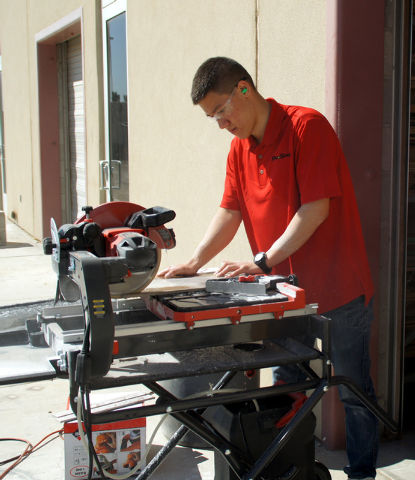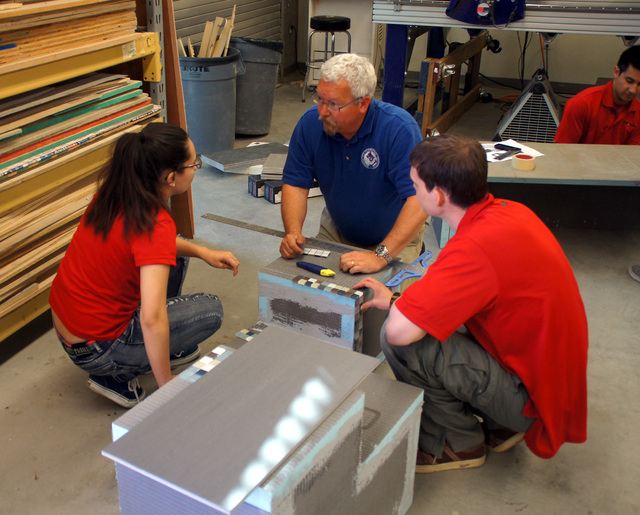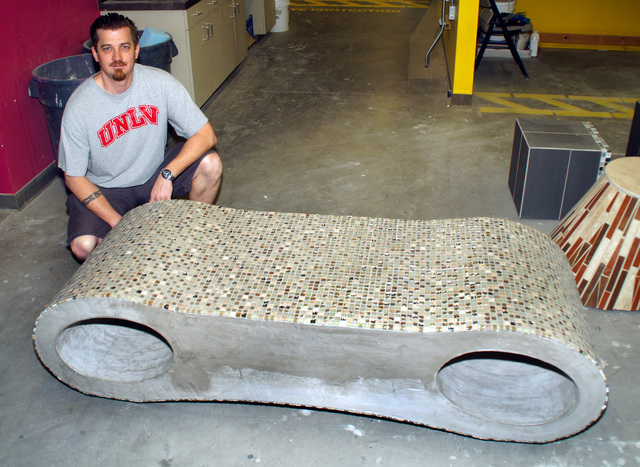Students learn furniture design
Seven students from the University of Nevada, Las Vegas School of Architecture have been meeting once a week for three hours since January, frantically racing against the clock to complete an elective course that’s only worth three credits. But don’t tell them it’s not time well spent. Real-world experience alone, coupled with future earnings potential once they enter the job market, could be a career booster.
These seven were chosen from a juried competition of 16 students who submitted drawings, computer models and artist renderings of benches using tile and stone as source materials. The competition was part of Coverings, the largest international tile and stone exposition and conference, which was April 29 to May 2 at the Las Vegas Convention Center.
Coverings partnered with the UNLV School of Architecture to develop a 13-week series of lectures and workshops titled “Mediations on Making — Exploring Furniture Design,” which gave students the opportunity to study furniture design and the constraints of tiles, construction and installation and fabrication processes. This competition was part of the course.
“These students are learning a lot, and I am learning a lot about tile,” said Jonathon Anderson, course director and assistant professor at the School of Architecture. “They are learning what it means to sit in a space and be ergonomically correct. I think people will be surprised at the refined use of tile and how students used it in these benches. I think people will also be shocked at the craftsmanship and that theses benches were done by students.”
Overall, the design phase for the benches took six weeks, and construction required an additional four weeks. In the beginning, the students didn’t know anything about tile and that it could be used for furniture, Anderson said. They had to take into account functionality of sitting on the benches, dimension restraints and the fact that these behemoths would weigh 200 to 300 pounds upon completion.
John Gassaway, a fourth-year architecture student, calls his bench the Binoc, which is an abstract version of binoculars. The surface is composed of a 9/16-inch mosaic layer of glass and stone with sides plastered in gray cement tones.
“My concept revolved around how we perceive the bench,” Gassaway said. “Your vision of things around you changes once you sit on the bench. I’m using this design as an expression of the material.”
Brenda Tena, a second-year interior architecture student, designed her bench around the desert theme of a plateau. She combined cerdomus tile, which has a wood grain look, with earth-tone terra cotta tile.
“Being precise in cutting the tile was the hardest part,” Tena said. “It was a rough start in the beginning, but has been very rewarding. I’d definitely be interested in designing more furniture with this material in the future.”
Andrew Martin, a fourth-year architecture student, used cream-colored porcelain tile, black slate and steel for his bench. He wanted his piece to look as if it was floating off the ground, which is why he used steel to sandwich the different layers together.
“I have a new-found respect for tile after doing this project,” Martin said. “It was hard trying to compose the bench into a small scale and not show the imperfections of the tile.”
Besides Coverings and the UNLV School of Architecture, major sponsors of the program were ProSpec, Arizona Tile, the National Tile Contractors Association, Rubi Tools, A. Bottini Enterprises Inc. and Wedi, makers of the premanufactured waterproof cement board used in the foundations of all the students’ benches.
“The experience you get from working with these actual materials was great,” said Arely Lopez, a third-year landscape/architecture student. “Using the table saw to cut the Wedi board was a little tough and took some muscle.”
Lopez also discovered that her original design for a modular bench with movable pieces was impractical because they would have been too heavy to shuttle around and could break the tile.
“I changed my design at the last minute because I didn’t feel the tile and realize its constraints,” said Andres Diaz, a fourth-year architecture student.
The students were given $5,000 worth of donated materials to share, plus a credit of $125 each to complete their individual benches.
“Such sharp minds these students have,” said Michael Whistler of the National Tile Contractors Association, who volunteered as an adviser for the project.
“We want people to realize the different ways tile can be used. This has been like training new help in my company. It’s been a great learning experience for all the students to understand the different sides of a tile job from taking it from a picture to building something that will last.”
Elena Grant, vice president of program development for National Trade Productions that produces the Coverings show, was one of the judges. A similar competition was held at the Savana College of Art and Design last year for the first time. UNLV won out this year. This is the second time Coverings has held its conference and exposition in Las Vegas.
“From a show and industry perspective, these students are the next generation, and we want them to understand the different uses of tile,” Grant stressed. “The students get to experience the show by being a part of it. This will help them when they move into their careers.”
About 20,000 attendees were expected this year at Coverings. During Coverings’ 25th anniversary celebration, attendees were given the opportunity to bid on the student benches in a silent auction with proceeds going to the Ceramic Tile Education Foundation and a charity selected by UNLV.
“It’s early in the students’ careers and we love that we are able to give them this platform to develop,” Grant said. “Coverings sees this as a great opportunity to educate students about the tile and stone industry and to showcase alternative uses of tile.”





















